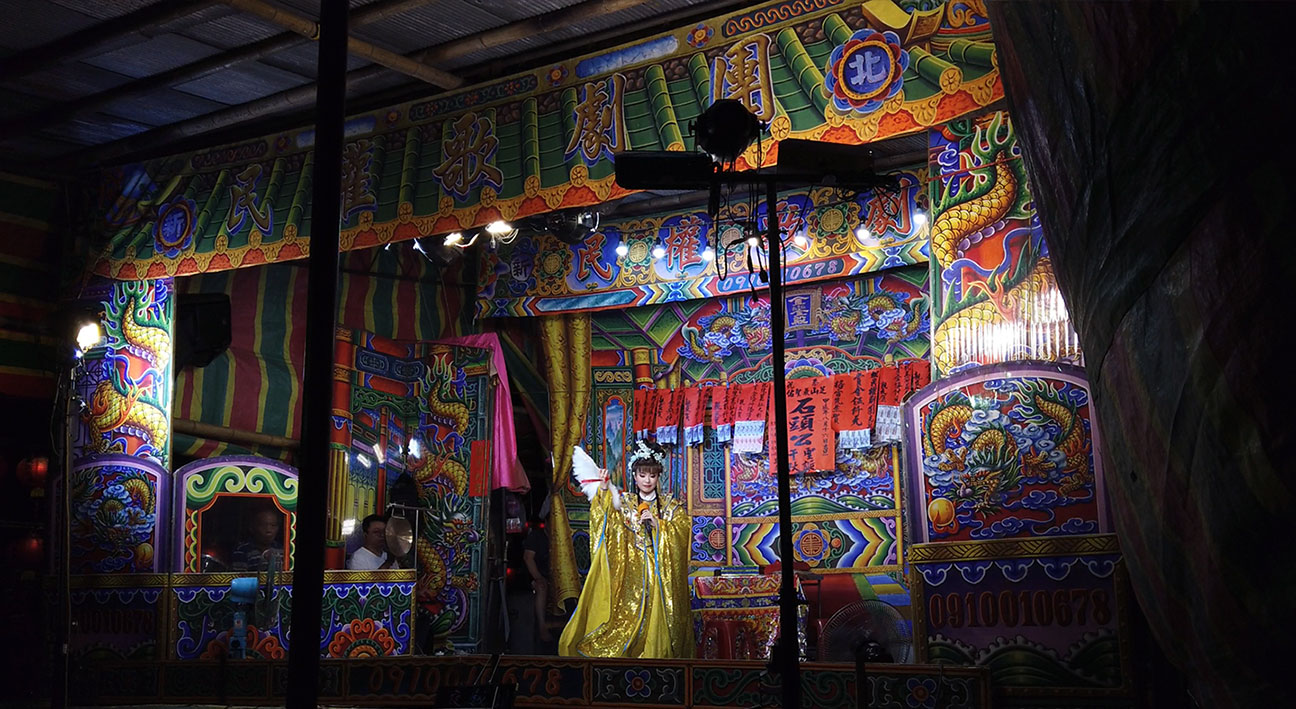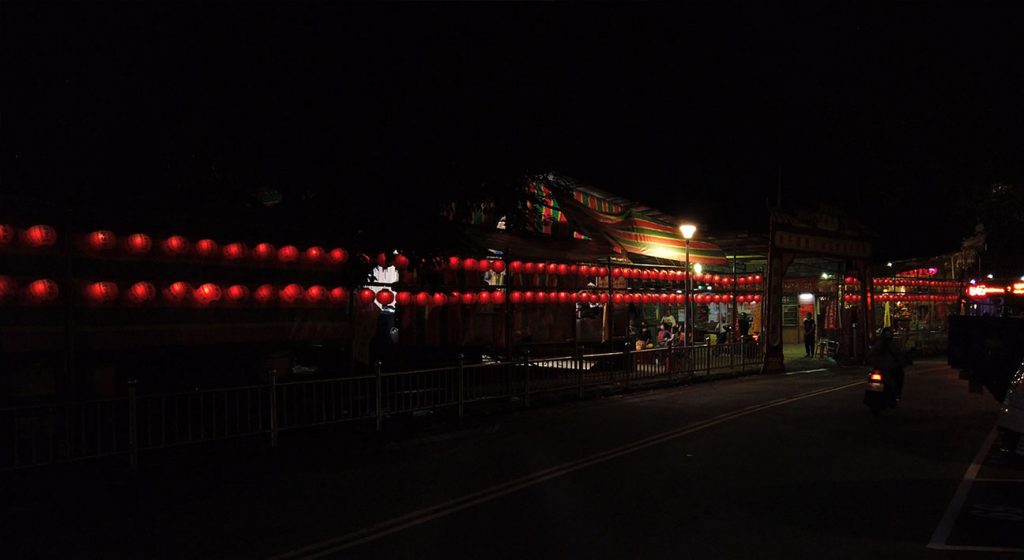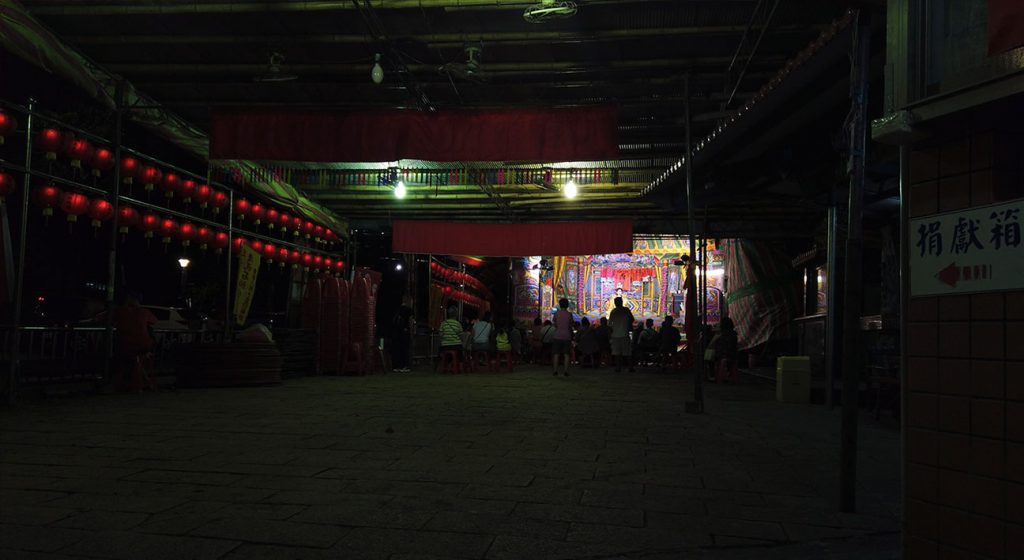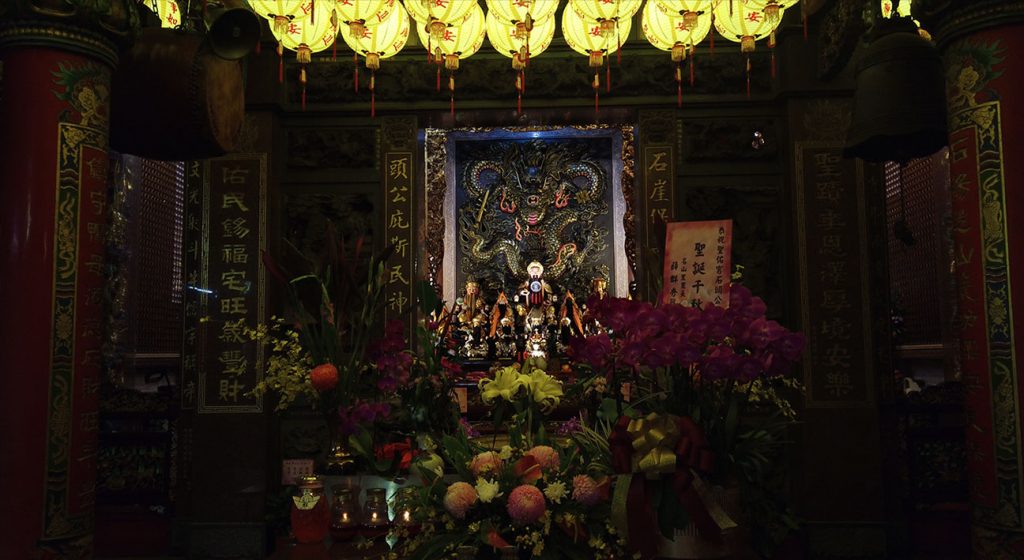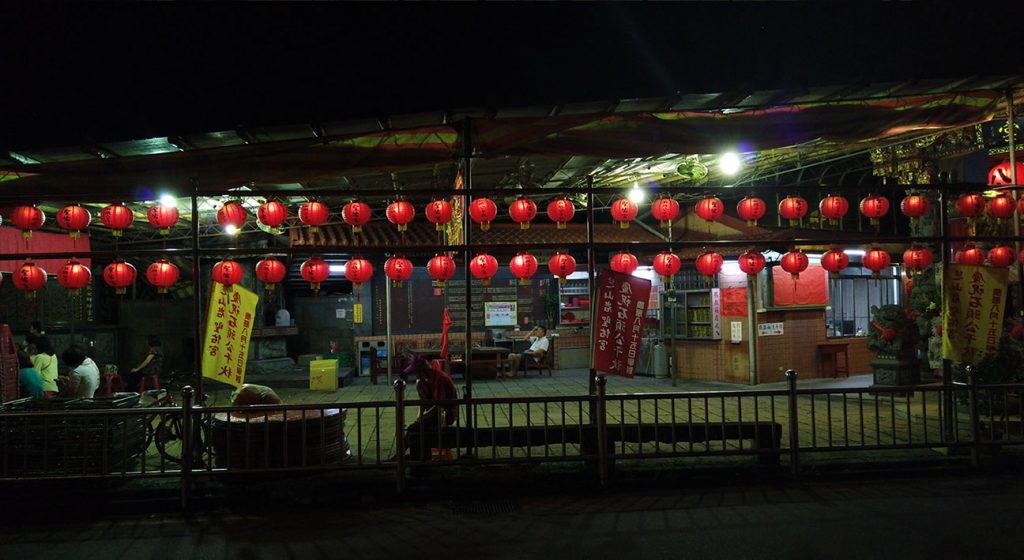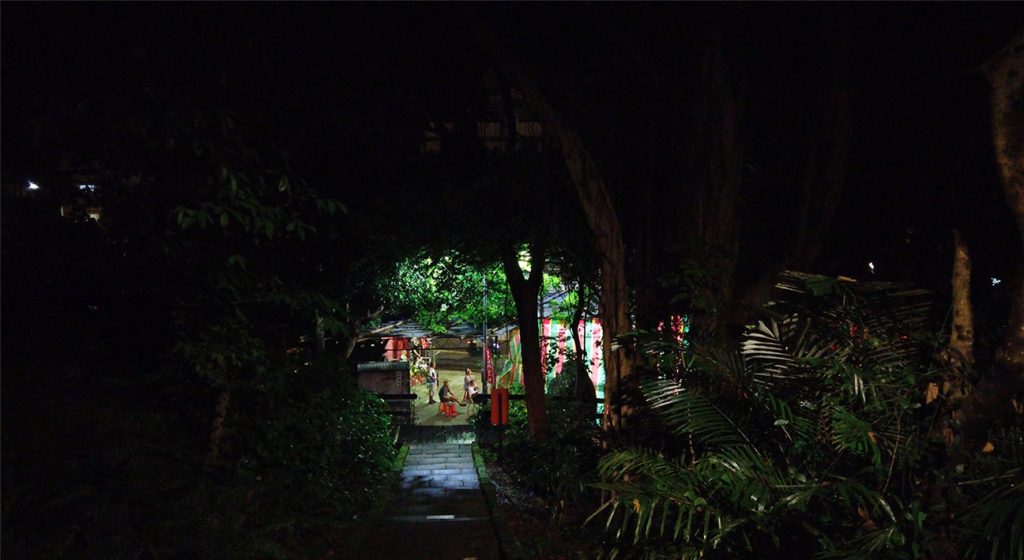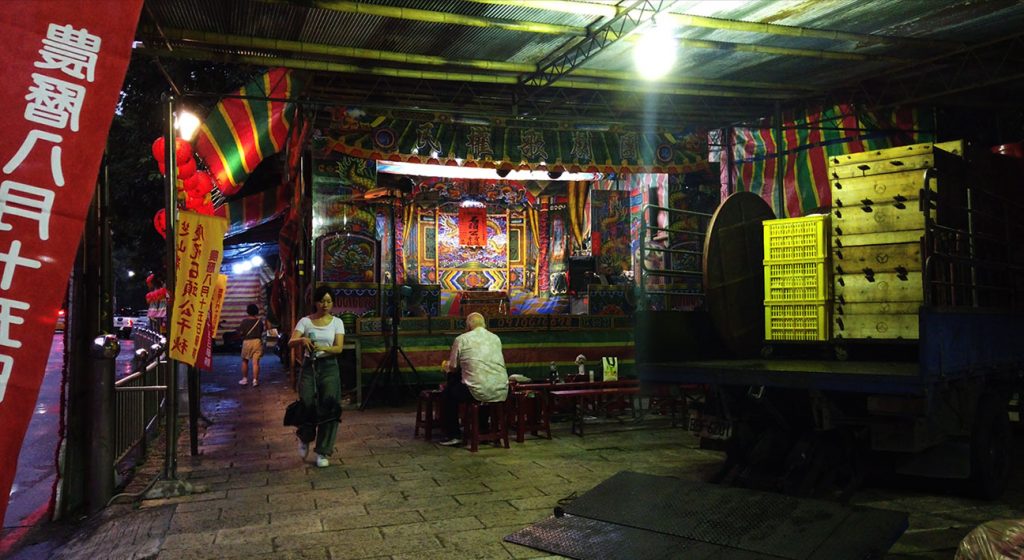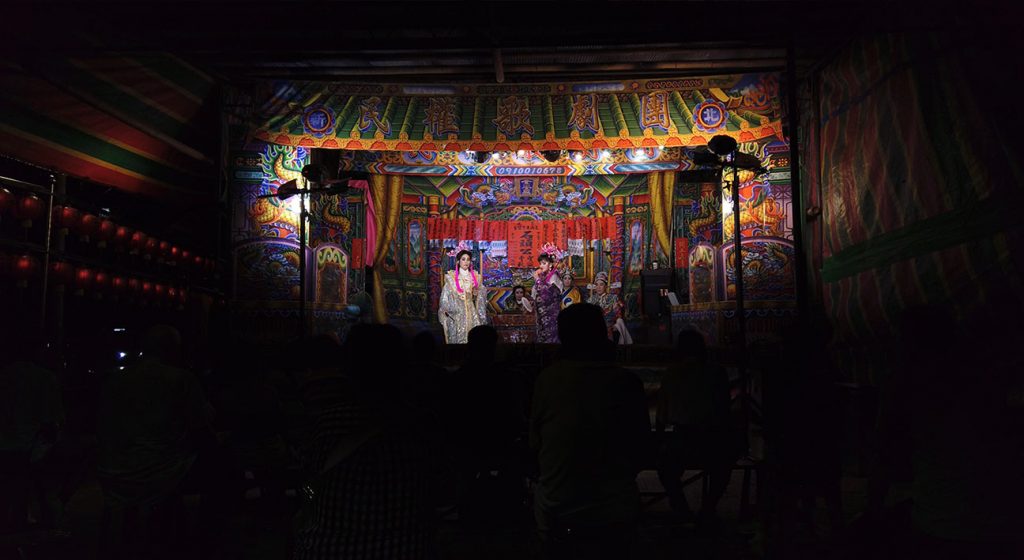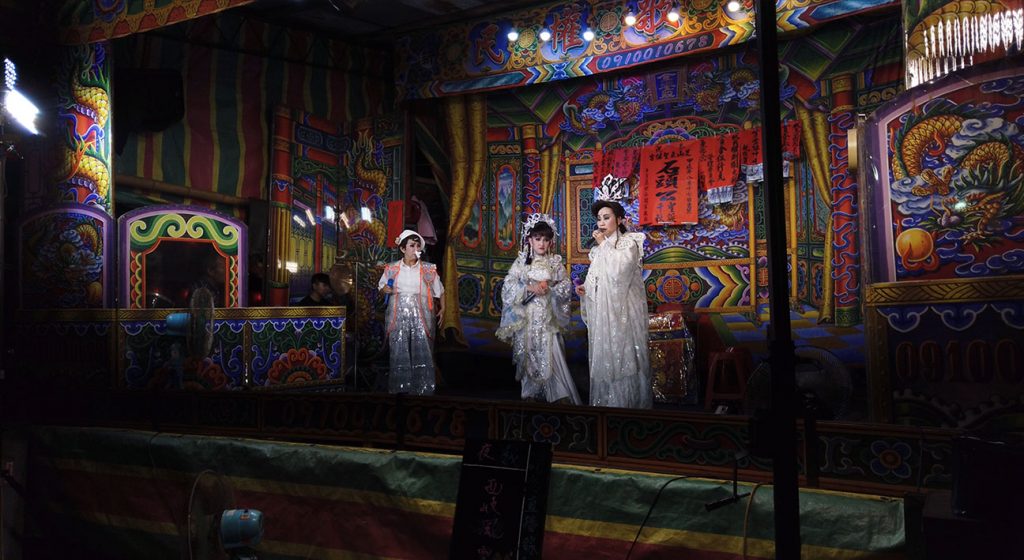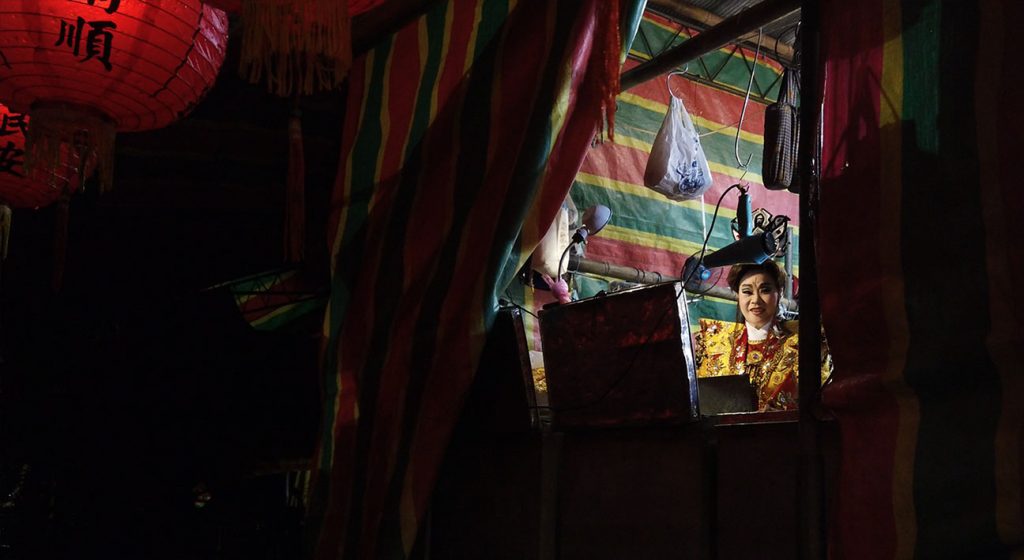After reviewing some shaky footage we had shot too hectically with a new gimbal camera, we decided to practice shooting hand-held panning shots in fast paced environments in a slower fashion. Since it was a rainy evening and already dark, a good place to work on this skill seemed to be the ShiLin night market, yet by mistake we jumped off the MRT too early and got off at the ZhiShan stop. Outside the station, without a plan of where to go, we accepted the guidance of a street sign that pointed towards ZhiShan Shengyou Temple, 芝山巖聖佑宮, 石頭公廟 in a distance of 806 meters. We followed the sign’s arrow down a large and busy road, which eventually turned into a smaller road and a footpath through a park, which led into some narrow, winding street, which led into an even narrower alley and another one, which then opened up into a bigger road again, where we saw, giddily for having managed to “find” our destination without the use of google directions, strings with red glowing lanterns that led towards a dimly lit, temporarily covered temple plaza. We entered the outdoor/indoor area whose altar was festively decorated with lots of fresh flowers, incense sticks, fruits and paper money and greeted the stone lions, whose red ribbon bows indicated that a temple celebration was going on. And indeed, when we turned around, what we saw at the other side of the temple plaza, was a lit up, temporarily erected opera stage. The painted awnings and the backdrop, which depicted the grand entrance court hall of a fairy tale palace were embellished with colorful abstractions of dragons with tails and heads surrounded by fire flames, cloud shapes and wave ornaments, name plaques with golden Chinese characters, purple snakes wrapping themselves around red columns and finely carved windows that framed the views of distant mountains. In the center above and below the stage was a string of painted Latin numbers, which we immediately embraced as the most important information to gather from this incredibly dense display, most likely because it was the only thing we registered with some certainty: 0910010678.
About twenty small red plastic chairs stood in loose formation in front of the stage, all of them had an object placed in their middle. A water bottle, an umbrella, a tea cup, a bag, a jacket, which most likely indicated that these seats were reserved for audience members, who would all eventually appear from an undisclosed location in order to claim their pre-chosen viewing spots, once the opera performance would start. Yet, as of now, the only person who was already sitting in front of the stage, in the last row a bit off to the side, was a man with short white hair and a beige shirt, who looked like a tourist from the US or Europe. We wanted to stay, but did not really know for what, so we went back to the altar and back to the stage several times, passing an old man on a stool near the road, and another one sitting at a table near a ceremonial oven in which a flickering fire waited for the next paper money offerings, until we discovered a narrow set of stairs that led up a mountain. Because the path was lit by a tall street lamp in that cinematic way anyone with a recording device has a hard time resisting to capture, we went up a couple of steps and started doing our exercise, which was trying to keep a very steady hand when slowly panning over some of the wet, shiny leaves of dark green palm fronds that turned some wind-vibration into a nervous flutter. After a couple of panning shots we walked down the stairs towards the temple and noticed – with some surprise – that the tourist man was still there. A plastic water bottle was placed next to him on the ground and when he, after some rummaging through a large black bag, started placing a battery operated fan directly in front of his face and fixed his gaze onto the stage, we knew he was not the kind of sightseeing traveler, who rushes in, takes a picture and runs off to the next attraction. But who was he? Maybe he spoke English and knew what was going? Maybe he even knew, when the performance would begin? We approached with this inquiry, and being given an answer, “the show starts at 7pm,” squeezed as many follow up questions as we could into the remaining time frame. And just like that began our introductory course on Taiwanese Opera, taught by the musicologist and devoted Taiwanese Opera fan, Gregory Dubinsky from San Francisco, who very generously shared his extensive knowledge and personal connections he had formed with some of the opera troupes.
The following stills are from two performances of the Min Quan Troupe (People Power Troupe) 民權歌劇團 performed on September 19th in the evening and the following day, September 20th in the evening at the ZhiShan Shengyou Temple, 芝山巖聖佑宮, 石頭公廟.
On September 23, 2024 we followed Gregory’s invitation to see 民安歌劇團, the Min’An Troupe (Peace for the People Troupe) at Wanying Temple in Songshan perform an evening show. 昨晚去松山的萬應宮看民安團演民戲 Since we had learned that Gregory would be returning to the US in less than a week, we decided to meet a bit earlier and do a pre-show interview. When the troupe leader, 何聖惠 He Sheng-hui, who Greg knows well, heard about this plan, she warmly welcomed us onto the stage. We set up in front of a row of pinned up red papers that not only acknowledged the donors of that evening’s show, but also displayed the actual money they had given. As the rain started pouring down and hammered onto the metal roof, its noise started drowning out the loud humming of several old, fiercely working fans that were functioning as the AC on the stage. While we were reassuring ourselves that we later on could use some AI noise remover to make Greg’s speech more audible, we totally forgot that we had left our equipment bags in front of the stage where there was no roof. Everything was soaked when we were finished with the interview, but no equipment got damaged. The bags are all dry again and several AI’s did amazing jobs filtering out the background noise and transcribing our interview, so that you can enjoy some short excerpts here:
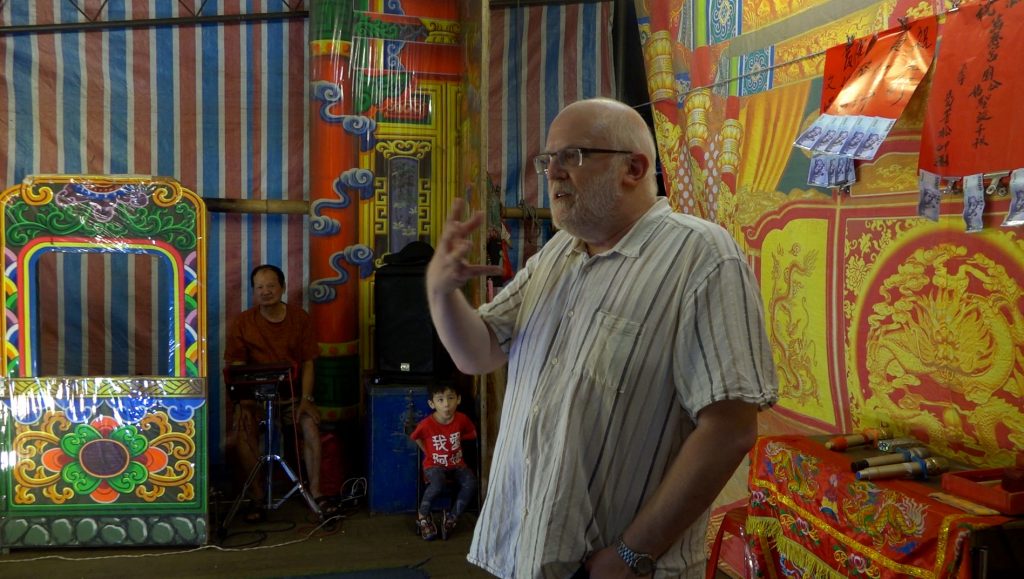
eteam: Thank you so much for agreeing to be on camera. Could you please introduce yourself?
GB: Certainly. My name is Gregory Dubinsky, folks in Taiwan call me 格雷先生, Mr. Greg, I have been coming to Taiwan just about every year for the past 14 or 15 years, spending two to four months every year here simply watching Traditional Opera.
There are several kinds. There is the kind that is going to be performed here tonight, often known in English as Taiwanese Opera, but because Taiwan is a multi-ethnic country, there are other kinds as well. So we have Hakka opera from the Hakka ethnic group that uses Hakka language, there is also Beijing Opera, which was already popular here in the 1910’s and 1920’s and became even more so with the arrival of large numbers of people from China in 1949. There are other types of Taiwanese Traditional Opera, like Bei Guan opera and Nan Guan Opera, which once were very, very popular. They are less popular now, because Taiwanese opera 歌仔戲, which is performed here tonight basically wiped all the competitors off the board starting in the 1950’s.
After this brief introduction, Greg goes on to give us a pretty extensive overview of the history of Taiwanese opera, but for brevity, we’ll jump ahead and ask him about the connection between Traditional Taiwanese Operas and Temple Fairs.
Thanks again to:
Gregory Dubinsky
民權歌劇團
民安歌劇團 – with special thanks to 何聖惠 He Sheng-hui
小飛霞歌劇團
Fulbright Taiwan – Foundation for Scholarly Exchange
